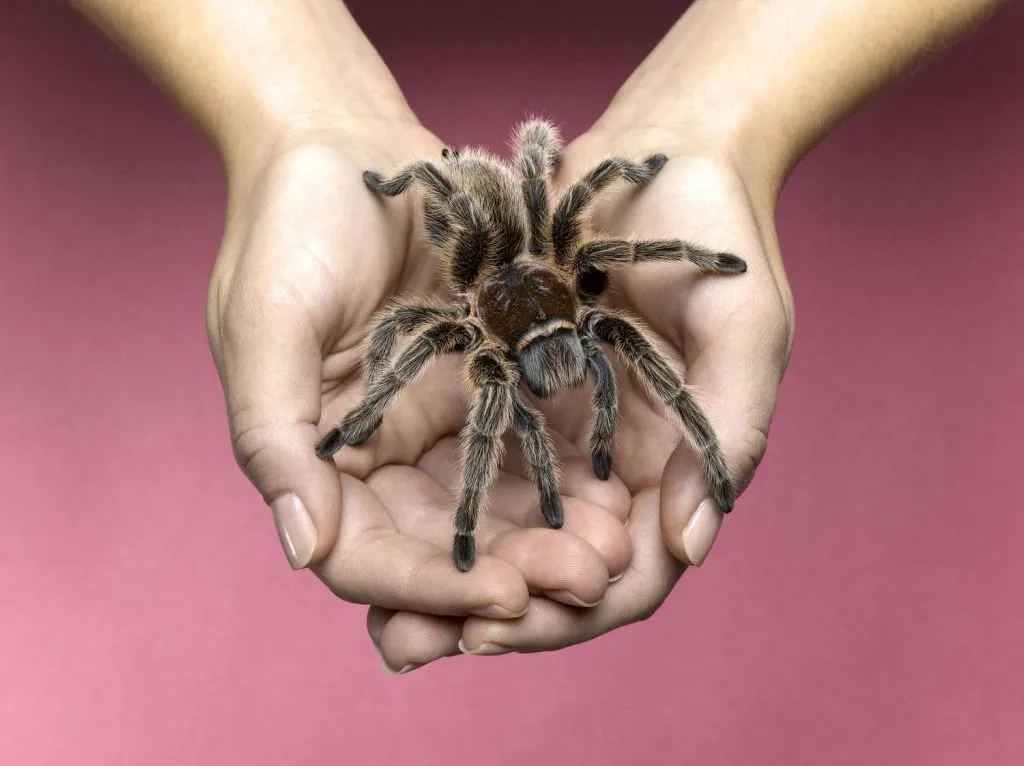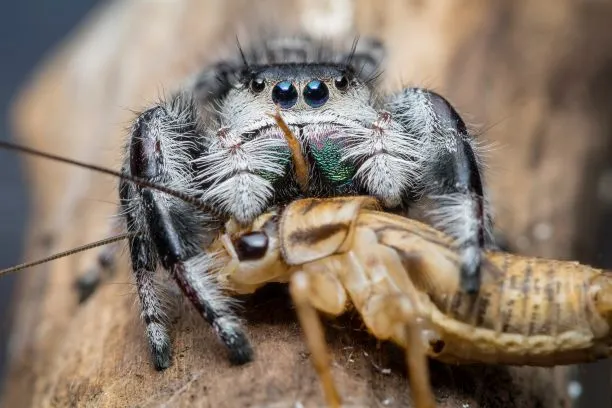What Do Tarantulas Eat?
Tarantulas, with their impressive size and captivating presence, are fascinating creatures to observe and care for. One of the most crucial aspects of tarantula ownership is understanding their dietary needs. These arachnids are primarily carnivorous, meaning their diet consists mainly of meat. But what exactly do tarantulas eat? The answer varies depending on the tarantula species and its natural habitat, but generally, they are opportunistic feeders that will consume a variety of prey. This guide will provide a comprehensive overview of what tarantulas eat, how often they need to be fed, and how to ensure your pet tarantula receives proper nutrition for a long and healthy life. Understanding their diet is fundamental to successful tarantula keeping.
The Natural Diet of Tarantulas
In the wild, tarantulas are voracious predators, primarily feeding on insects, but their diet can be surprisingly diverse based on their environment and the opportunities available. They are ambush predators, waiting patiently for prey to come within striking distance. Their natural diet consists mainly of insects, but they are also known to consume small vertebrates, such as lizards, small frogs, and even small birds or rodents when the opportunity arises. This varied diet provides them with the necessary nutrients to survive and thrive in their natural habitats. Knowing what a tarantula eats in the wild can help inform responsible pet ownership and ensure their diet is as close to nature as possible.
Insects Tarantula Staple Food

Insects form the cornerstone of a tarantula’s diet, providing essential protein and other vital nutrients. Crickets, roaches, mealworms, and other insect species are readily available food sources for pet tarantulas. The type of insect you choose can influence the nutritional content of the tarantula’s diet, so it’s essential to offer a variety to ensure a balanced intake. The size of the insects should correspond to the size of the tarantula; it’s generally recommended that prey items be no larger than the tarantula’s abdomen. The practice of gut-loading insects – feeding them a nutritious diet before offering them to your tarantula – is a good way to enhance the nutritional value of the meal.
Crickets as a Tarantula Food Source
Crickets are perhaps the most commonly used food source for pet tarantulas, and for good reason. They are relatively easy to acquire, breed, and maintain. Crickets provide a good source of protein, and the lively chase of a cricket can provide enrichment for the tarantula. However, crickets can also be a source of parasites, so it’s important to source them from a reputable supplier or breed them yourself. Before feeding crickets to your tarantula, it is recommended to dust them with calcium and vitamin supplements to boost their nutritional value. The size of the cricket is also important; never offer a cricket larger than the tarantula’s body to avoid any potential harm.
Roaches Nutritional Benefits for Tarantulas
Roaches, especially species like Dubia roaches, are an excellent dietary option for tarantulas, offering higher nutritional value compared to crickets. They have a better protein-to-chitin ratio, making them easier to digest. Roaches are also less likely to carry parasites and are generally easier to manage in a captive environment. They are less prone to escaping, which makes them a safer option. Roaches also tend to move less erratically than crickets, making them easier for the tarantula to catch and consume. When feeding roaches, consider the size of the roach relative to the tarantula, similar to cricket feeding guidelines.
Other Insects That Tarantulas Consume

Besides crickets and roaches, tarantulas can eat a variety of other insects, offering a more diverse and balanced diet. Mealworms and superworms are also popular options, but they should be used in moderation due to their high-fat content. Other insects such as grasshoppers, waxworms (treat), and various types of beetles can also be offered as part of a varied diet. The key is to offer a mix of insect types to ensure that the tarantula receives a broad spectrum of nutrients. Always ensure the insects you offer are free from pesticides and parasites.
Small Vertebrates in Tarantula Diets
While insects form the main part of a tarantula’s diet, tarantulas in the wild will occasionally consume small vertebrates. This can include small lizards, frogs, and even baby mice or small birds if the opportunity arises. Offering such food items to pet tarantulas is generally not recommended as a regular part of their diet because of the risk of parasites. However, for larger tarantula species, pre-killed pinky mice may be offered very infrequently. It’s crucial to ensure that any vertebrate prey is pre-killed to prevent any risk to the tarantula. Always research the specific dietary needs of your tarantula species before considering vertebrate prey.
Feeding Frequency For Tarantulas
The frequency with which you should feed your tarantula depends on several factors, including its age, size, and species. Juvenile tarantulas, which are in their growth phase, usually require more frequent feeding than adults. Overfeeding is also something to be avoided; it’s better to slightly underfeed than overfeed a tarantula, as this can lead to health problems. Providing the right amount of food at the right intervals is essential for your tarantula’s health and wellbeing. Always ensure that your tarantula has access to fresh, clean water, regardless of how often you feed them.
How Often Should You Feed Your Tarantula

As a general guideline, juvenile tarantulas should be fed more frequently, possibly two to three times a week. Sub-adults can be fed once or twice a week, and adult tarantulas usually only need to be fed once every week or two. Some adult tarantulas may even eat less frequently. The most crucial aspect is to observe your tarantula and adjust the feeding schedule accordingly. Observe whether the prey is consumed quickly or if it is left in the enclosure for extended periods. Always remove any uneaten food within 24 hours to prevent mold and mites.
Adjusting Feeding Based on Tarantula Size
The size of your tarantula significantly impacts the amount of food it needs. A smaller tarantula will require smaller prey and more frequent feedings. As they grow, you will need to adjust the size of the prey items and feeding intervals. Monitor the tarantula’s abdomen; a slightly rounded abdomen indicates a healthy, well-fed tarantula. A very large, distended abdomen could indicate overfeeding. Be mindful that the feeding needs will also vary between different species of tarantulas. Always do your research on your specific tarantula species to tailor your feeding schedule for their unique requirements.
Signs of a Well-Fed Tarantula
Knowing the signs of a healthy tarantula is as important as knowing what they eat. A well-fed tarantula will have a rounded abdomen, indicating that it has stored reserves of food. It will be active and exhibit normal behaviors like web-spinning (if applicable) and exploration of its habitat. A healthy tarantula will also appear alert, responsive to stimuli, and have a clean enclosure. The appearance of the tarantula is a good indication of its health, and these visual cues can provide valuable insights into their well-being. Observing these signs regularly will help to identify any potential health issues early on.
Recognizing Overfeeding in Tarantulas

Overfeeding is detrimental to a tarantula’s health. Overfed tarantulas can become obese, which can affect their mobility and overall health. A tarantula that has a very large, swollen abdomen is a clear sign of overfeeding. Other signs include a lack of interest in food, lethargy, and a general decrease in activity levels. Overfeeding can also put unnecessary stress on the tarantula’s internal organs. It is always better to underfeed than to overfeed. Regular monitoring of the tarantula’s behavior, size, and feeding habits is essential to prevent this common pitfall.
Nutritional Needs for Tarantulas
Just like any other living creature, tarantulas need a balanced diet to thrive. The primary components of their diet include protein, fats, and essential micronutrients. The specific nutritional requirements can vary depending on the species, but protein is the most important macro-nutrient. The insects that tarantulas consume provide the necessary protein and fats. A varied diet, combined with proper supplementation, is key to ensuring that your tarantula receives all the nutrients it needs for optimal health and development. A balanced diet helps tarantulas with healthy growth, molting, and general vitality.
Vitamins and Supplements
While insects provide a good source of nutrients, they may sometimes lack certain vitamins and minerals. It is therefore recommended to supplement the diet of your tarantula by dusting the insects with vitamin and mineral supplements. Calcium and vitamin D3 are particularly important, as they help with the tarantula’s exoskeleton development. You can find these supplements at most pet stores specializing in reptiles and invertebrates. Gut-loading the insects before feeding can also increase the nutritional value they provide. Supplementation ensures that your tarantula gets all the nutrients required for a healthy life.
Water for Tarantulas

Water is essential for all living creatures, and tarantulas are no exception. Provide a shallow water dish with fresh, clean water at all times. Ensure that the water dish is shallow enough so that your tarantula cannot drown. Water helps them to stay hydrated and aids in their molting process. Regularly check the water dish and refill it as needed. The water dish should be placed away from the heat source in the enclosure to prevent the water from evaporating too quickly. Providing proper hydration is crucial for the tarantula’s overall health and well-being.
Feeding Challenges and Solutions
Tarantula keepers may sometimes face challenges related to their pets’ feeding habits. There are various reasons why a tarantula might refuse to eat, and understanding these issues can help owners resolve them. These issues can range from environmental factors to molting cycles. Observing your tarantula’s behavior and understanding its potential needs is the key to dealing with any feeding-related challenges. Patience is critical, and it is essential not to panic or force-feed a tarantula.
Refusal to Eat Why and What to Do
There are several reasons why a tarantula might refuse food. One of the most common reasons is that it is in pre-molt. During this period, the tarantula will stop eating to conserve energy for the molting process. Changes in the environment, such as temperature fluctuations or stress, can also affect appetite. Ensure that the enclosure is at the correct temperature and humidity levels for your specific tarantula species. Another cause could be stress from handling or overcrowding. Provide a stress-free environment, and always leave the tarantula alone for a few days after handling. If the tarantula continues to refuse food for an extended period, consult a veterinarian or experienced tarantula keeper.
Dealing With Uneaten Prey

Uneaten prey left in the tarantula’s enclosure can cause several problems. The prey can stress the tarantula or even injure it during molting. Uneaten insects also introduce the risk of mold and mites, which can harm the tarantula’s health. It’s essential to remove any uneaten prey within 24 hours. This practice helps maintain the cleanliness of the enclosure and prevents potential health risks. Keeping the enclosure clean and free from uneaten food is a critical part of responsible tarantula ownership. Use long tweezers to remove any uneaten prey safely.
Understanding the dietary needs of a tarantula is a fundamental part of responsible pet ownership. From understanding what tarantulas eat to how often they need to be fed, this guide provides a comprehensive overview of tarantula nutrition. By providing a balanced diet, appropriate feeding frequency, and proper supplements, you can ensure your tarantula lives a long, healthy, and fulfilling life. Regular observation, understanding your tarantula’s unique needs, and maintaining a clean environment are all vital aspects of providing excellent care. This knowledge will help you to give the best possible care for your captivating arachnid companion.
